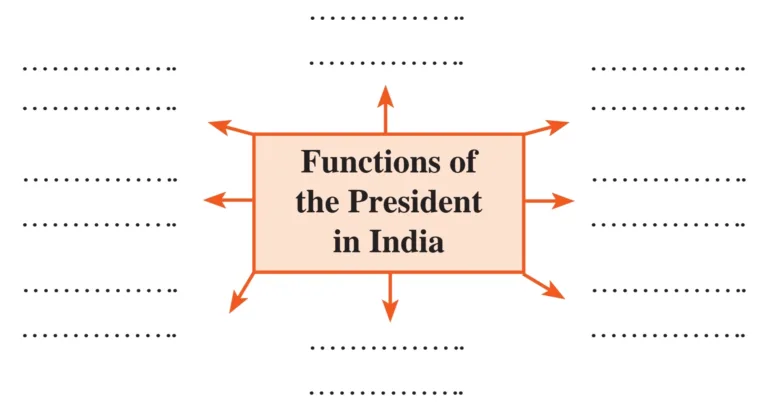Chapter 3 - The Union Executive
1. Choose the correct option and rewrite the statement.
(1) In India, the executive power is vested with the …………… .
(President, Prime Minister, Speaker)
Ans: President
(2) The tenure of the President is of ………… years.
(Three, Four, Five)
Ans: Five
(3) The Council of Ministers is led by the ………. .
(Party chief, Prime Minister, President)
Ans: Prime Minister
2. Find and write.
(1) The President, the Prime Minister, the Council of Minister are called the
Ans: Executive
(2) During the parliamentary session the period around 12 noon is known as
Ans: Zero Hour
3. Write on following concepts in your own words.
(1) Impeachment procedure
Ans:
(i) The responsibility of protecting the Constitution is borne by the President.
(ii) But if any act of the President violates the Constitution, the Parliament has the authority to remove him.
(iii) This process is known as the impeachment process.
(iv) The procedure for impeachment is as follows:
(a) Any one House can lay the charge of violation of the Constitution.
(b) The investigation of the charge is carried out by the other House.
(c) If the resolution is passed by a special (2/3rd) majority of both houses, the President can be removed from his post.
(2) No-confidence motion
Ans:
(i) In the Parliamentary system of government, the Legislature tries to keep control over the Executive.
(ii) The Executive stays in power until it enjoys the support of the majority in the Lok Sabha.
(iii) The members of the Lok Sabha can move a No-confidence motion by simply expressing “We do not have confidence in the government”.
(iv) If the motion is passed with majority support, the Council of Ministers (the Executive) has to resign.
(v) Thus, this is the most effective way to keep a check on the Council of Ministers.
(3) Jumbo ministry
Ans:
(i) A huge Council of Ministers with more than necessary ministers is referred to as a Jumbo Ministry.
(ii) There was a trend to keep a large Council of Ministers in our country.
(iii) Later, a constitutional amendment was made to limit the size of the Council of Ministers.
(iv) As per this amendment, the number of ministers in the Council should not be more than 15% of the total number of members in the Lok Sabha.
4. Answer in brief.
(1) Enumerate the functions of the Council of Ministers.
Ans: The functions of the Council of Ministers are as follows:
(i) The Council of Ministers takes initiative in the process of lawmaking by drafting the bills or proposals.
(ii) It introduces and discusses the bills and proposals in the House.
(iii) It introduces bills on various subjects like education, agriculture, industry, health, foreign relations, etc. in the Parliament, conducts discussions on them, and tries to get them approved by the Parliament.
(iv) It also takes on the responsibility of implementing the policies approved by Parliament.
(2) How does the Parliament keep a check on the Council of Ministers ?
Ans: The Parliament keeps a check on the Executive in the following ways:
(i) The bills and proposals presented by the Council of Ministers are discussed in Parliament.
(ii) These discussions and debates help the members scrutinize the bills or proposals, point out the shortcoming, and help in the creation of healthy laws.
(iii) During Parliamentary sessions, the proceedings of the House begin with questions asked by the members of the House. The concerned Ministers are expected to give satisfactory answers to these questions.
(iv) During the Parliamentary sessions, the period around noon is called as Zero Hour’. During this period, any VITA question of public importance can be raised and discussed.
(v) The Parliament can pass a No- confidence motion on the Executive. If the motion is passed with majority support, then it has to resign.
5. Complete the concept picture.

Ans:

